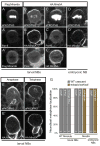aPKC phosphorylates Miranda to polarize fate determinants during neuroblast asymmetric cell division
- PMID: 19375318
- PMCID: PMC2689075
- DOI: 10.1016/j.cub.2009.03.056
aPKC phosphorylates Miranda to polarize fate determinants during neuroblast asymmetric cell division
Abstract
Background: Asymmetric cell divisions generate daughter cells with distinct fates by polarizing fate determinants into separate cortical domains. Atypical protein kinase C (aPKC) is an evolutionarily conserved regulator of cell polarity. In Drosophila neuroblasts, apically restricted aPKC is required for segregation of neuronal differentiation factors such as Numb and Miranda to the basal cortical domain. Whereas Numb is polarized by direct aPKC phosphorylation, Miranda asymmetry is thought to occur via a complicated cascade of repressive interactions (aPKC -| Lgl -| myosin II -| Miranda).
Results: Here we provide biochemical, cellular, and genetic data showing that aPKC directly phosphorylates Miranda to exclude it from the cortex and that Lgl antagonizes this activity. Miranda is phosphorylated by aPKC at several sites in its cortical localization domain and phosphorylation is necessary and sufficient for cortical displacement, suggesting that the repressive-cascade model is incorrect. In investigating key results that led to this model, we found that Y-27632, a Rho kinase inhibitor used to implicate myosin II, efficiently inhibits aPKC. Lgl3A, a nonphosphorylatable Lgl variant used to implicate Lgl in this process, inhibits the formation of apical aPKC crescents in neuroblasts. Furthermore, Lgl directly inhibits aPKC kinase activity.
Conclusions: Miranda polarization during neuroblast asymmetric cell division occurs by displacement from the apical cortex by direct aPKC phosphorylation. Rather than mediating Miranda cortical displacement, Lgl instead promotes aPKC asymmetry by regulating its activity. The role of myosin II in neuroblast polarization, if any, is unknown.
Figures





References
-
- Doe CQ. Neural stem cells: balancing self-renewal with differentiation. Development. 2008;135:1575–1587. - PubMed
-
- Knoblich JA. Mechanisms of asymmetric stem cell division. Cell. 2008;132:583–597. - PubMed
-
- Lee CY, Robinson KJ, Doe CQ. Lgl, Pins and aPKC regulate neuroblast self-renewal versus differentiation. Nature. 2006;439:594–598. - PubMed
Publication types
MeSH terms
Substances
Grants and funding
LinkOut - more resources
Full Text Sources
Molecular Biology Databases

